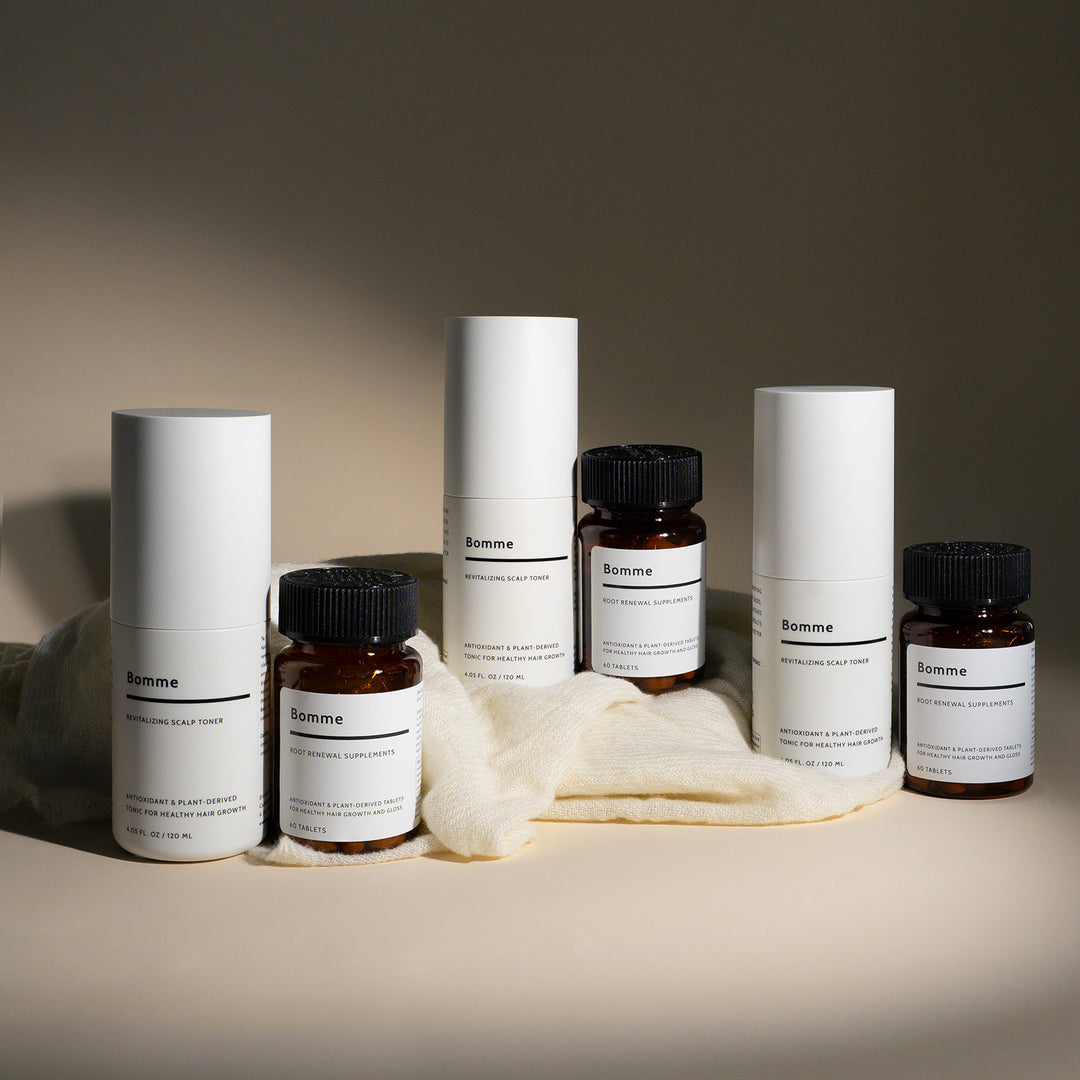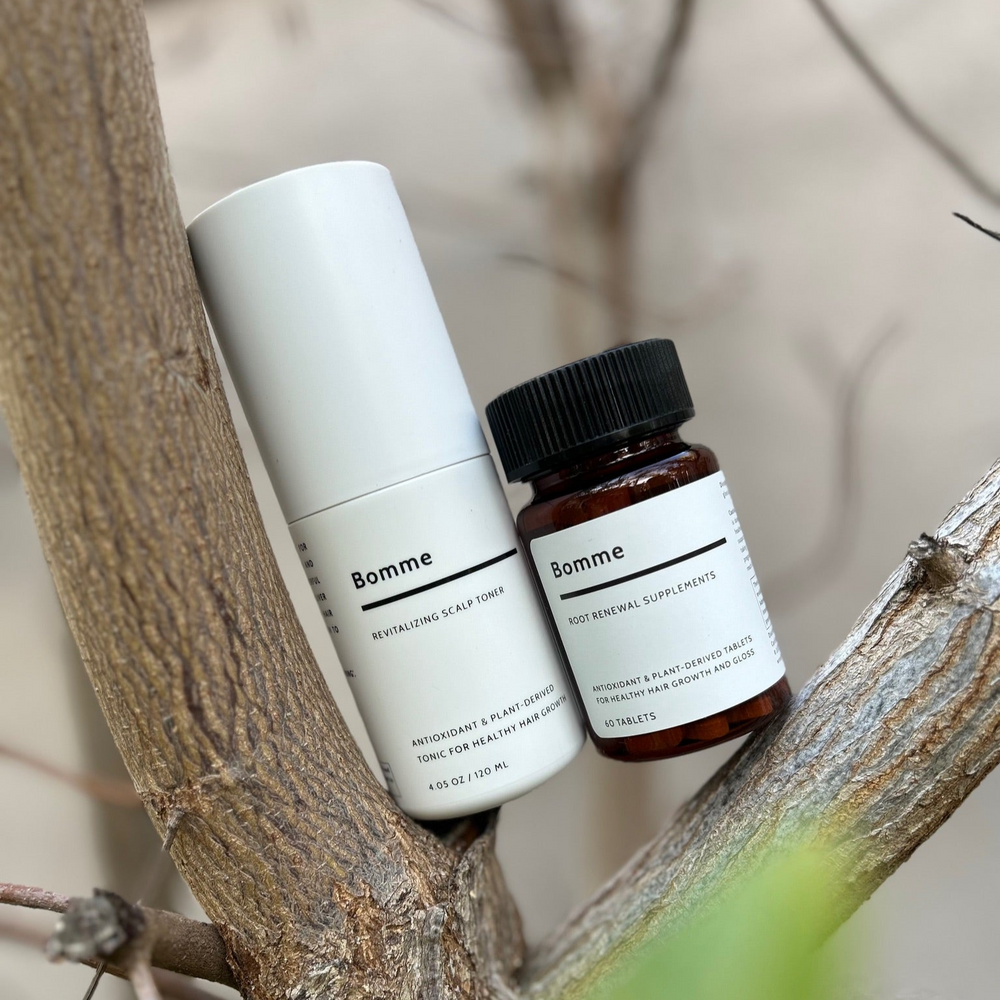For decades, the hair loss conversation has had one main villain: DHT — short for dihydrotestosterone — a byproduct of testosterone that can shrink hair follicles over time1.
From prescription finasteride to “natural” saw palmetto supplements, the traditional playbook has been: block DHT, save the hair.
And for some, it works — at least partially. But blocking DHT isn’t the whole story. It can come with side effects like low libido, mood changes, and hormonal disruption2. And for many women, who naturally have lower testosterone levels, aggressively shutting down DHT often does little to address what’s actually causing their hair to thin.
In my own journey with hair loss, I learned that while hormones play a role, they’re far from the only factor — and a more balanced, scalp-focused approach can make a profound difference.
The Inflammation Factor
Science is now looking beyond hormones and uncovering another hidden driver: chronic scalp inflammation.
One key player? Interleukin-6 (IL-6) — a type of chemical messenger in the body that sparks inflammation 3,4.
When IL-6 is elevated in the scalp — whether from stress, hormonal changes, environmental pollutants, or even diet 5 — it can quietly damage follicles. Over time, this inflammation creates an environment where hair grows weaker, thinner, and eventually stops coming in at all.
Put simply: you can reduce DHT all you want, but if inflammation is still raging, healthy regrowth will be an uphill battle.
From “Hormone War” to “Scalp Ecosystem”
This shift in understanding is inspiring a more holistic approach to hair wellness — one that’s less about shutting down hormones and more about restoring balance to the scalp.
The most effective strategies now combine:
- Internal nutrition to supply the building blocks for healthy follicles.
- Topical anti-inflammatory care to calm the scalp and protect against damage.
This two-part system supports a healthy scalp ecosystem where hair can grow stronger, thicker, and healthier — making it especially effective for:
- Androgenic alopecia – male and female pattern thinning
- Telogen effluvium – shedding from stress, postpartum changes, or illness
- Diffuse thinning – caused by aging or environmental factors
Where Bomme Fits In
Bomme’s Korean-formulated system was built on this exact philosophy. At its core is BLH308, a proprietary botanical complex that takes a gentler, more targeted approach:
- Balances DHT by gently regulating 5-alpha-reductase, the enzyme that produces it6, rather than blocking it outright.
- Helps reduce IL-6 activity7 to calm inflammation and protect follicles — without altering hormone levels.
The full system includes:
- Root Renewal Supplements — nutrients like zinc8, niacin9, and plant antioxidants10 to reduce inflammation and fuel follicle metabolism.
- Revitalizing Scalp Toner — clinically shown to reduce shedding by 71.6% in 4 weeks, while improving density, gloss, and scalp comfort.
- Revitalizing Scalp Shampoo (coming soon) — gently cleanses while rebalancing scalp hydration and barrier function. Launching later this month — formulated to complement the full Bomme system for even better results.
- Optional LED Red Light Therapy — boosts circulation and follicle activity with low-level light stimulation11.
Based on clinical studies. Individual results may vary.
Why It Matters
In clinical research on Bomme’s hero ingredients, results went beyond “less shedding.” By four weeks, participants saw visible new growth, improved density, and enhanced hair gloss — all signs of a scalp environment actively recovering.
Because Bomme’s formulas work without harsh hormone blockers, they’re suitable for both men and women — including those who’ve avoided conventional treatments due to side effects.
I’ve seen firsthand how discouraging hair loss can be, and it’s why I wanted Bomme to offer something different — effective, safe, and grounded in both science and lived experience.
The Takeaway
The future of hair wellness isn’t about waging war on a single hormone. It’s about creating a healthy scalp ecosystem — managing inflammation, replenishing nutrients, and restoring your hair’s natural growth rhythm.
For anyone who’s tried the “block DHT” route and been left underwhelmed (or dealing with unwanted side effects), this inflammation-targeted approach offers a smarter, hormone-friendly way forward.
I created Bomme to offer a science-backed, hormone-friendly alternative for those who want results without compromising their well-being.
Discover the Bomme system and learn how our inflammation-targeted formulas can help restore your hair’s natural strength and fullness.
Author: Eunjoo Chang is the founder of Bomme, launched in the U.S. in Autumn 2024. A breast cancer survivor, she partnered with Korean scientist Dr. Jong-moon Jeong to bring his plant-based hair health formula, BLH308, to market — offering clean, science-backed solutions that restore hair and confidence without hormones or harsh chemicals.
References
- Kaufman KD. Androgens and alopecia. Mol Cell Endocrinol. 2002;198(1-2):89-95. DOI: 10.1016/S0303-7207(02)00372-6. ↩
- Traish AM, Hassani J, Guay AT, Zitzmann M, Hansen ML. Adverse side effects of 5α-reductase inhibitors therapy: persistent diminished libido and erectile dysfunction. J Sex Med. 2011;8(3):872-884. DOI: 10.1111/j.1743-6109.2010.02157.x. ↩
- Kwack MH, Ahn JS, Kim MK, Kim JC, Sung YK. Dihydrotestosterone-inducible IL-6 inhibits elongation of human hair shafts by suppressing matrix cell proliferation and promotes regression of hair follicles in mice. J Invest Dermatol. 2012;132(1):43-49. DOI: 10.1038/jid.2011.274. ↩
- Ito T, Ito N, Bettermann A, et al. Interleukin-6 regulates hair follicle regression through apoptosis. J Invest Dermatol. 2005;124(4):915-922. DOI: 10.1111/j.0022-202X.2005.23687.x. ↩
- Arck PC, Handjiski B, Peters EMJ, et al. Stress and the hair follicle: exploring the connections. Am J Pathol. 2006;168(3):812-821. DOI: 10.2353/ajpath.2006.050784. ↩
- Sawaya ME, Price VH. Different levels of 5α-reductase type I and II, aromatase, and androgen receptor in hair follicles from women and men with androgenetic alopecia. J Invest Dermatol. 1997;109(3):296-300. DOI: 10.1111/1523-1747.ep12335779. ↩
- Hagemann T, Robinson SC, Thompson RG, et al. The IL-6 system in inflammation and cancer. J Clin Invest. 2001;107(3):275-281. ↩
- Ogawa Y, Kawamura A, Shimada T, et al. The effect of zinc on hair growth: a review. Dermatol Ther. 2018;8(3):431-444. DOI: 10.1007/s13555-018-0252-z. ↩
- Bhat YJ, Latief I, Hassan I. Vitamin B3 in dermatology. Indian J Dermatol Venereol Leprol. 2017;83(6):678-684. DOI: 10.4103/ijdvl.IJDVL_1027_16. ↩
- Nichols JA, Katiyar SK. Skin photoprotection by natural polyphenols: anti-inflammatory, antioxidant and DNA repair mechanisms. Arch Dermatol Res. 2010;302(2):71-83. DOI: 10.1007/s00403-009-1001-3. ↩
- Avci P, Gupta GK, Clark J, et al. Low-level laser (light) therapy (LLLT) for treatment of hair loss. Lasers Surg Med. 2014;46(2):144-151. DOI: 10.1002/lsm.22170. ↩













